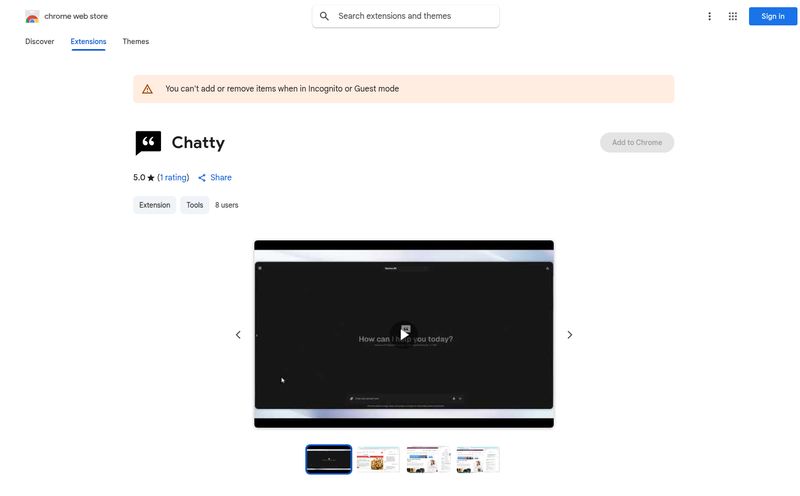We all use ChatGPT. It’s like the office water cooler, the brainstorming partner, and the late-night coding assistant all rolled into one. But can we be honest for a second? The default interface is... fine. It's functional. But for those of us who live and breathe this stuff—SEOs, content creators, developers—"fine" just doesn't cut it. It feels like driving a high-performance engine with a dashboard made of sticky notes and hope.
I've lost count of the number of times I've had a brilliant idea, a killer prompt, or a perfect piece of code, only to have it swallowed by the endless, unsearchable scroll of my chat history. It’s a digital graveyard of good intentions. So, when I stumbled upon a tool called ChatKit, claiming to be a “refined ChatGPT UI,” my curiosity was definitely piqued. Another AI wrapper? Maybe. But this one seemed different. I’ve been playing around with it for a bit, and I have some thoughts. Let’s get into it.
So, What Exactly Is ChatKit?
First off, let's clear something up. ChatKit isn’t another AI model trying to compete with OpenAI or Google. Thank goodness. Instead, think of it as a custom-built cockpit for the AI engines you already use. It’s a clean, feature-rich interface that connects directly to your own API key—whether that's from OpenAI, Gemini, Azure, or even a custom model. You're still using the powerful models you trust, you're just getting a much, much better way to interact with them.
It takes the raw power of something like GPT-4 and puts it into a workspace that feels like it was designed by people who actually use AI for their work. It’s all about enhancing your workflow, not replacing your tools.

Visit ChatKit
The Features That Genuinely Make a Difference
A lot of tools boast a long list of features just to look impressive. But with ChatKit, a few of them really stood out to me as solving actual, everyday frustrations. These aren't just bells and whistles; they're workflow savers.
Finally, You Can Bring Your Own API Key
This is a big one for me. Using your own OpenAI (or other) API key has a couple of huge advantages. First, you have more control over which model you use. Want to test the absolute latest release like GPT-4o the second it's available via API? You can do that. You're not waiting for the public-facing tool to catch up. Second, depending on your usage, it can be more cost-effective than a fixed monthly subscription. You pay for what you use. For power users, this flexibility is everything. ChatKit also offers its own credits if you'd rather not fiddle with API keys, which is a nice option to have.
Real-Time Context is a Content Creator's Dream
Okay, this feature is just plain cool. ChatKit allows you to use a URL as a live source of context for your chat. Let that sink in. You can drop in a link to a competitor's blog post and ask the AI to analyze its tone, structure, and SEO strategy. You can feed it a SERP link and have it generate a content brief aimed at outranking the top results. I've used this to quickly generate meta descriptions based on a product page or summarize a dense research paper without endless copy-pasting. It’s a massive time-saver and it grounds the AI's output in real, current data. It's an incredible tool for anyone doing competitive analysis or content gap analysis.
A Searchable Chat History. I Repeat, Searchable.
Remember that digital graveyard I mentioned? ChatKit builds a mausoleum with a full-time librarian. The full-text search across your entire chat history is, without exaggeration, a reason to switch all by itself. I found a complex prompt for generating schema markup that I wrote weeks ago in about five seconds. It turns your chat history from a messy archive into a personal, searchable knowledge base. Every good idea, every useful snippet, every clever turn of phrase is now instantly accessible. It’s brilliant.
More Than Just Text: Voice and Prompts
Sometimes the best ideas come when you're not at a keyboard. ChatKit integrates voice input using the Whisper API, and it’s surprisingly accurate. I’ve found myself dictating blog post outlines while pacing around my office, which feels much more natural for brainstorming. It also has text-to-speech, so you can have it read responses back to you. Add in features like savable prompt templates for your recurring tasks and chat bookmarks to pin important conversations, and the whole experience just becomes smoother. Less friction, more creating.
A Balanced Look at the Experience
No tool is perfect, right? So let's talk honestly about the highs and the potential lows.
On the plus side, the multi-model support is a huge win for future-proofing. Being able to switch between OpenAI, Gemini, and others in the same interface is fantastic. And I have to say it again: the option for a one-time payment is a breath of fresh air in a world choking on SaaS subscriptions. I am so tired of a dozen different $10-$20 monthly charges. Give me a tool I can buy once and own. That alone gets a massive thumbs up from me.
On the other hand, the very thing that makes it powerful—requiring an API key—can be a small hurdle for absolute beginners. It’s not difficult to get an OpenAI key, but it’s an extra step that the standard ChatGPT website doesn’t have. Also, the team seems to be adding new features almost weekly. This is mostly a good thing, a sign of active development! But for some folks, constant updates can be a bit disruptive. It's a minor point, but worth mentioning.
So, What's the Price Tag?
This is where things get interesting. At the time of writing, I don't have a specific price sheet in front of me, as these things can change. However, the most compelling piece of information I found is the existence of a one-time payment option. In an industry dominated by recurring monthly fees, this is a standout feature. The idea of paying once for a piece of software that I can use with my own pay-as-you-go API key is incredibly appealing. I’d strongly recommend checking their official website for the latest and most accurate pricing details, but the model itself is a huge selling point.
Is ChatKit the Right Tool for You?
So, here’s my final take. If you’re a casual AI user who just asks for recipes or poems a few times a week, the standard ChatGPT interface is probably all you need. Stick with it. It’s free and simple.
But if you are a professional—an SEO specialist, a PPC manager, a content strategist, a developer, a researcher—and you feel constrained by the basic UI, then ChatKit is absolutely worth a serious look. It’s for the power user who wants more control, better organization, and features that directly translate to increased productivity. It’s for the person who sees AI not as a toy, but as a core part of their professional toolkit. It transforms your interaction with AI from a simple conversation into a structured, efficient, and searchable workflow.
Frequently Asked Questions
Do I need my own OpenAI API key for ChatKit?
You have options! You can use your own API key from OpenAI, Gemini, or Azure, which gives you more control and pay-as-you-go pricing. Alternatively, ChatKit offers its own credit system if you prefer a simpler setup.
Is ChatKit a monthly subscription?
One of its biggest appeals is the option for a one-time payment. This is a great alternative to the common monthly subscription model, though you should always check their website for the most current pricing structures.
Can I use models other than ChatGPT with ChatKit?
Yes. It's built to be flexible and supports models from OpenAI (like various GPT versions), Google (Gemini), Azure, and even custom models. This makes it a versatile and long-lasting tool.
How is ChatKit really different from the regular ChatGPT website?
The main differences are in the workflow and features. ChatKit adds a searchable chat history, the ability to use URLs for real-time context, voice input, prompt templates, and multi-model support, all within a more refined interface.
Is my chat history private with ChatKit?
Since you're primarily using your own API key, your conversations are a matter between you and the AI provider (like OpenAI). ChatKit is the interface, not the one processing the core data. This is often seen as a significant privacy advantage over using third-party services that might store your data for training purposes.
A Better Dashboard for Your Brain
At teh end of the day, tools are about workflow. They’re about removing friction between an idea and its execution. For me, ChatKit does just that. It takes the raw, incredible power of modern AI models and puts it into a user-centric package that respects my time and my history. It gets rid of that flimsy dashboard of sticky notes and gives you a control panel worthy of the engine you're running. If you're an AI power user, it just might be the upgrade you've been looking for.



